|
|
|
Sort Order |
|
|
|
Items / Page
|
|
|
|
|
|
|
| Srl | Item |
| 1 |
ID:
126660
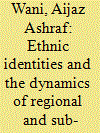

|
|
|
|
|
| Publication |
2013.
|
| Summary/Abstract |
The concept of regional and sub-regional identity as well as regional autonomy has captured the stage of Social Science. The regional autonomy aspirations and the sense of regional and sub-regional identity have offered a new dimension to the assertiveness of ethnic group. Regional identity demands in South and Southeast Asian societies have followed a uniform pattern. These regional autonomy demands evolved over a large span of time may be located in specific geographical and environmental spaces. At one level, these demands remained humane and inclusive, incorporating and reflecting broader human and universal values. At the other level, they acquired the traits of particularism which in the later stages of building multi-cultural and multi-ethnic nation states posed many problems. The plurality of politics is the hallmark of Jammu and Kashmir (J&K) State, and this polarity is essentially the result of cultural diversities that criss-cross the geographical and cultural landscape of Kashmir. The J&K State is not only a conglomerate of three distinct regions - Jammu, Kashmir, and Ladakh - but there are also regions within regions marked off from one another by geography, culture, and history. The politics of regional and sub-regionalism based on region, religion, caste, ethnicity, and so on continues to be stubbornly informed by their respective histories and cultures - thus the resistance against hegemony and the demand for sub-regional autonomies and Hill Development Councils. This article attempts at, looking into the dynamics of these assertions, its impact on the politics of the state, and to delineate the role of different socio-political and historical forces in shaping regional and sub-regional assertions in J&K without, however, suppressing the relative significance of different identity markers.
|
|
|
|
|
|
|
|
|
|
|
|
|
|
|
|
| 2 |
ID:
126661
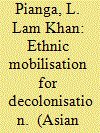

|
|
|
|
|
| Publication |
2013.
|
| Summary/Abstract |
This article attempts to communicate the methodological tension between subjectivity and objectivity by recording the aspiration of communities who are problematised both by colonialism and the modern nation-state. It highlights how colonial policy and practice contribute to the postcolonial imbroglio in Northeast India. It delineates how British colonial cartography always gave priority to 'administrative convenience' in the demarcation of boundaries, resulting in the division of ethnic community. It argues that Northeast India and the Indo-Burma borderland are not yet decolonised, as the government of India, without any rearrangement or alteration, adopts the colonial administrative boundaries, which divided ethnic communities. Neither the State Reorganisation Act (1956) nor the North-Eastern Areas (Reorganisation) Act (1971) fulfilled the aspiration of the segmented communities in the northeast, as they did in the mainland. The article also argues that the responses of the government of India towards the problems in Northeast India react to the manifested symptoms of the deep-rooted political problem rather than getting to the crux of the problem to find a solution.
|
|
|
|
|
|
|
|
|
|
|
|
|
|
|
|
| 3 |
ID:
182482
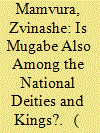

|
|
|
|
|
| Summary/Abstract |
This article examines the elite construction of cultural landscapes in Harare. Since assuming the reins of power in the Zimbabwe African Nation Union (ZANU) in 1977, Robert Mugabe invented a political culture that conflated him with spirit mediums whom the nationalist movement had elevated to national deities and dead kings. Mugabe continued to cultivate this political culture in the post-colonial era using different discourses of self-presentation. The place-renaming exercise that the Mugabe regime implemented immediately after independence was part of Mugabe’s self-legitimating efforts. This article establishes that the place-renaming system in Harare projected Mugabe as a divine king.
|
|
|
|
|
|
|
|
|
|
|
|
|
|
|
|
| 4 |
ID:
128510
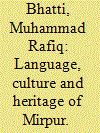

|
|
|
|
|
| Publication |
2013.
|
| Summary/Abstract |
Language, culture and heritage are the cornerstones of civilizations - ancient, medieval and present. It is very difficult to draw the lines of demarcation between languages, cultures and heritage of different regions
because these are interwoven and overlapping. Language is a medium of -expression of feelings, emotions, reason, prudence, passions and vision. Mankind since time irnmemorial has evolved different modes of expression, écalled tongues, dialects or languages. A language is a living organism, 'which originates, develops and dies. There are so many languages that have died away and are extinct now. l Culture re?ects the macro and micro behavioural structure of a society :generally accepted. All practices that people undertake, adopt or follow {consciously for their economic, social, political, moral, religious or spiritual
satisfaction come under the garb of culture. These practices, rites, rituals, =;customs, traditions, arts, architecture, food and dress etc. become part of . their individual and collective life and pass on from generation to -generation. It is a process of history and differentiates one community from other, one nation from other and one time span from the other. It is e a tree that has its roots in the past, branches in the present and shades future.
|
|
|
|
|
|
|
|
|
|
|
|
|
|
|
|
| 5 |
ID:
171958
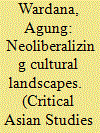

|
|
|
|
|
| Summary/Abstract |
In Bali, rapid conversion of agricultural land has been framed by opinion leaders and mass media as an indication of an agrarian crisis. The government responded by nominating subak (a traditional water management system) landscapes for world heritage status, which was achieved in 2012. Instead of mitigating land conversion, world heritage status has incentivized local farmers to sell their agricultural land. This article examines market-based conservation strategies by investigating their conceptual foundation. It argues that a romantic characterization of subak, combined with neoliberal assumptions which conceive of the land crisis in Bali through a rational choice lens, has led to a counter-productive market-based solution managed in a technocratic manner, ignoring the structural conditions which have been the main cause of land conversion. Thus, the neoliberal response to Bali’s agrarian crisis, rather than conserving subak landscapes and empowering local farmers, has contributed to the further marginalization of local farmers and their landscapes.
|
|
|
|
|
|
|
|
|
|
|
|
|
|
|
|
| 6 |
ID:
181278
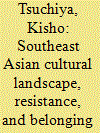

|
|
|
|
|
| Summary/Abstract |
The diversity of national imaginings within the East Timorese resistance movement against the Indonesian Occupation (1975–99) became visible through the country's post-independence politics. Namely, the contradiction between the returnee leaders and those who fought in East Timor over the representation of FRETILIN (the major nationalist movement since 1974) has been an important fault line. This article attempts to understand this discrepancy through a comparison of FRETILIN's campaigns in Tetun and Portuguese and how different audiences interpreted them. The article argues that FRETILIN modified its international rhetoric when it became a popular Tetun language movement to attract Timorese commoners. The Tetun version of FRETILIN provided sources for Timorese national imaginings based on local beliefs, sacred landscapes, and Southeast Asian social relations that deviated from how international audiences understood FRETILIN. This article thus contributes to the literature on Southeast Asian resistance and nationalism by revealing Timorese ideologies of resistance and nationhood.
|
|
|
|
|
|
|
|
|
|
|
|
|
|
|
|
|
|
|
|
|